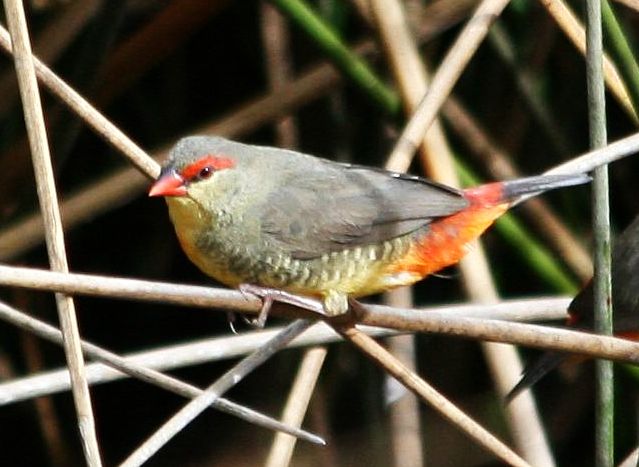 The Zebra Waxbill, Amadava subflava (also known as the Gold or Orange-Breasted Waxbill), is one of the tiniest of all African birds available to aviculturists. With their bright yellow bellies and brilliant red rumps, the males are a sight to behold. A mere 3 to 3.5 inches in length, they are a delight to keep and breed, and quite hardy as well.
The Zebra Waxbill, Amadava subflava (also known as the Gold or Orange-Breasted Waxbill), is one of the tiniest of all African birds available to aviculturists. With their bright yellow bellies and brilliant red rumps, the males are a sight to behold. A mere 3 to 3.5 inches in length, they are a delight to keep and breed, and quite hardy as well.
Natural History
The Zebra Finch is found throughout much of sub-SaharanAfrica. It favors grasslands and lightly-wooded savannas (please see photo), but has adapted to farms and village outskirts as well. Grass-seeds and insects comprise the bulk of its diet.
A larger and more colorful subspecies, Clarke’s Waxbill, Amadava subflava clarkii, occupies the southern portion of the range. Unfortunately, it is not common in private or public collections.
Housing
Zebra Waxbills adapt well to captivity, and a pair will thrive and even breed in a moderately sized finch cage. They are quite active, however, and so should be given as much room as possible. Like all waxbills, Zebras really come into their own in an outdoor aviary, where they may be kept in colonies or with other small finches.
Although generally quite hardy, Zebra Waxbills cannot tolerant cold temperatures or extended periods of damp weather. In temperate climates, they should be brought indoors at summer’s end. Typical room temperatures are fine, and European hobbyists report that they do well even at 55-60 F.
Diet
A high quality finch seed mix should form the basis of the diet; millet sprays and similar naturalistic treats will also be greatly appreciated.
Small mealworms, crickets and waxworms, sprouts, greens and Egg Food should also be offered on a regular basis. Your waxbills will benefit greatly from the opportunity to search for live prey. Wild caught insects (please see article below) should also be provided when available.
Breeding
Zebra Waxbills are often reliable breeders, but parenting skills and fertility rates vary. They construct a huge, bulky nest which may be situated in a dense bush, or an open or closed nest box. Wild pairs often appropriate the abandoned nests of weavers and other birds. Long grasses are preferred for nest-building, although commercial nesting hair may be accepted.
 A typical clutch consists of 4 to 6 eggs, which are incubated by both parents. The young hatch in 12 days, but may not fledge until 3 weeks or so later. Zebra Waxbill chicks are impossibly small, and bear tiny white puffs of down atop their heads; please check the video below for a look at some of the oddest little birds you’ll ever see.
A typical clutch consists of 4 to 6 eggs, which are incubated by both parents. The young hatch in 12 days, but may not fledge until 3 weeks or so later. Zebra Waxbill chicks are impossibly small, and bear tiny white puffs of down atop their heads; please check the video below for a look at some of the oddest little birds you’ll ever see.
Nests should not be removed after the chicks are independent, as they and the parents may roost within at night.
Multiple pairs may be kept in outdoor aviaries. Breeders may become territorial, but serious aggression is rare, especially if live shrubs and bushes are planted to provide retreats and sight barriers.
Further Reading
Video: hand feeding a Zebra Waxbill chick
Breeding Zebra Fiches (with great photos)
Live Food for Finches and Waxbills
Male Zebra Waxbill image referenced from wikipedia and originally posted by Alan Manson
Acacia Bild image referenced from wikipedia and originally posted by Marco Schmidt
 That Bird Blog – Bird Care and History for Pet Birds
That Bird Blog – Bird Care and History for Pet Birds



